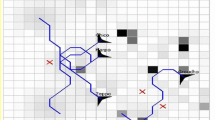Abstract
In this paper, we present a discrete-time optimization framework for target tracking with multi-agent systems. The “target tracking” problem is formulated as a generic semidefinite program (SDP) that when paired with an appropriate objective yields an optimal robot configuration over a given time step. The framework affords impressive performance guarantees to include full target coverage (i.e. each target is tracked by at least a single team member) as well as maintenance of network connectivity across the formation. Key to this work is the result from spectral graph theory that states the second-smallest eigenvalue—λ 2—of a weighted graph’s Laplacian (i.e. its inter-connectivity matrix) is a measure of connectivity for the associated graph. Our approach allows us to articulate agent-target coverage and inter-agent communication constraints as linear-matrix inequalities (LMIs). Additionally, we present two key extensions to the framework by considering alternate tracking problem formulations. The first allows us to guarantee k-coverage of targets, where each target is tracked by k or more agents. In the second, we consider a relaxed formulation for the case when network connectivity constraints are superfluous. The problem is modeled as a second-order cone program (SOCP) that can be solved significantly more efficiently than its SDP counterpart—making it suitable for large-scale teams (e.g. 100’s of nodes in real-time). Methods for enforcing inter-agent proximity constraints for collision avoidance are also presented as well as simulation results for multi-agent systems tracking mobile targets in both ℝ2 and ℝ3.
Similar content being viewed by others
Explore related subjects
Discover the latest articles, news and stories from top researchers in related subjects.References
Spletzer, J., Taylor, C.: Dynamic sensor planning and control for optimally tracking targets. Int. J. Rob. Res. 22(1), 7–20 (2003)
Kim, Y., Mesbahi, M.: On maximizing the second smallest eigenvalue of a state-dependent graph laplacian. IEEE Trans. Automat. Contr. 51, 116–120 (2006)
Winfield, A.F.T.: Distributed sensing and data collection via broken ad hoc wireless connected network of mobile robots. In: Parker, G.B.L.E., Barhen, J. (eds.) Distributed Autonomous Robotic Systems, vol. 4, pp. 273–282. Springer, New York (2000)
Arkin, R., Diaz, J.: Line-of-sight constrained eploration for reactive multiagent robotic teams. In: AMC 7th International Workshop on Advanced Motion Control, Maribor, 3–5 July 2002
Sweeney, J., Brunette, T.J., Yang, Y., Grupen, R.A.: Coordinated teams of reactive mobile platforms. In: Proceedings of the International Conference on Robotics and Automation (ICRA), pp. 99–304. Washington, DC (May 2002)
Pereira, G.A.S., Das, A.K., Kumar, V., Campos, M.F.M.: Decentralized motion planning for multiple robots subject to sensing and communication constraints. In: Proceedings of the Second Multi-Robot Systems Workshop, pp. 267–278. Washington, DC (March 2003)
Wagner, A.R., Arkin, R.C.: Communication-sensitive multi-robot reconnaissance. In: Proceedings of the IEEE International Conference on Robotics and Automation (ICRA), pp. 2480–2487. IEEE, Piscataway (2004)
Sweeney, J.D., Grupen, R.A., Shenoy, P.: Active qos flow maintenance in controlled mobile networks. In: Proceedings of the Fourth International Symposium on Robotics and Automation (ISRA). IEEE, Queretaro (2004)
Powers, M., Balch, T.: Value-based communication preservation for mobile robots. In: 7th International Symposium on Distributed Autonomous Robotic Systems, Toulouse, 23–25 (June 2004)
Hsieh, M.A., Cowley, A., Kumar, V., Taylor, C.J.: Towards the deployment of a mobile robot network with end-to-end performance guarantees. In: International Conference on Robotics and Automation (ICRA) 2006, Orlando (April 2006)
LaValle, S., Gonzalez-Banos, H., Becker, C., Latombe, J.: Motion strategies for maintaining visibility of a moving target. In: Proceeding of the IEEE Int. Conference on Robotics and Automation. pp. 731–736, Albuquerque (April 1997)
Stamos, I., Allen, P.: Interactive sensor planning. In: Computer Vision and Pattern Recognition Conference, pp. 489–495. Santa Barbara (June 1998)
Fabiani, P., Gonzalez-Banos, H., Latombe, J., Lin, D.: Tracking a partially predictable object with uncertainties and visibility constraints. J. Auton. Robots 38(1), 31–48 (2001)
Liu, Z., Ang Jr. M.H., Seah, W.K.G.: A potential field based approach for multi-robot tracking of multiple moving targets. In: Proc. 1st International Conference on Humanoid, Nanotechnology, Information Technology, Communication and Control, Environment, and Management, Manila (March 2003)
Jung, B.: Cooperative target tracking using mobile robots. Ph.D. dissertation, University of Southern California, Los Angeles (2005)
Krishna, K.M., Hexmoor, H., Sogani, S.: A t-step ahead constrained optimal target detection algorithm for a multi sensor surveillance system. In: Proceedings of IEEE/RSJ International Conference on Intelligent Robot and Systems, pp. 1840–1845. Edmonton (October–November 2005)
Mirzaei, F.M., Mourikis, A.I., Roumeliotis, S.I.: On the performance of multi-robot target tracking. In: Accepted to IEEE International Conference on Robotics and Automation (ICRA) 2007, Rome (April 2007)
Shucker, B., Bennett, J.K.: Target tracking with distributed robotic macrosensors. In: Proceedings of MILCOM 2005, Atlantic City (October 2005)
Stroupe, A., Balch, T.: Value-based observation with robot teams (vbort) for dynamic targets. In: Proceedings of IROS 2003, Las Vegas (September 2003)
Gennaro, M.D., Jadbabaie, A.: Decentralized control of connectivity in multi-agent systems. In: Proc. IEEE Conf. on Decision and Control, San Diego (December 2006)
Boyd, S., Vandenberghe, L.: Convex Optimization. Cambridge Unviersity Press, Cambridge (2004)
Isler, V., Khanna, S., Spletzer, J., Taylor, C.: Target tracking with distributed sensors: the focus of attention problem. J. Comput. Vis. Image Underst. 100, 225–247 (1988) (Special Issue on Attention and Performance in Computer Vision)
Mourikis, A.I., Roumeliotis, S.I.: Optimal sensing strategies for mobile robot formations: resource-constrained localization. In: Proceedings of Robotics: Science and Systems, Cambridge (June 2005)
Advanced Optimization Laboratory: Addendum to the SeDuMi User Guide Version 1.1 Advanced Optimization Laboratory. McMaster University. http://sedumi.mcmaster.ca/ (2006)
Lofberg, J.: Yalmip: a toolbox for modeling and optimization in matlab. In: Proceedings of the CACSD Conference. Taipei, Taiwan. http://control.ee.ethz.ch/ joloef/yalmip.php (2004)
The MOSEK Optimization Tools Version 3.2 (Revision 8) User’s Manual and Reference. MOSEK ApS. http://www.mosek.com (2008)
Author information
Authors and Affiliations
Corresponding author
Rights and permissions
About this article
Cite this article
Derenick, J., Spletzer, J. & Hsieh, A. An Optimal Approach to Collaborative Target Tracking with Performance Guarantees. J Intell Robot Syst 56, 47–67 (2009). https://doi.org/10.1007/s10846-008-9302-x
Received:
Accepted:
Published:
Issue Date:
DOI: https://doi.org/10.1007/s10846-008-9302-x





